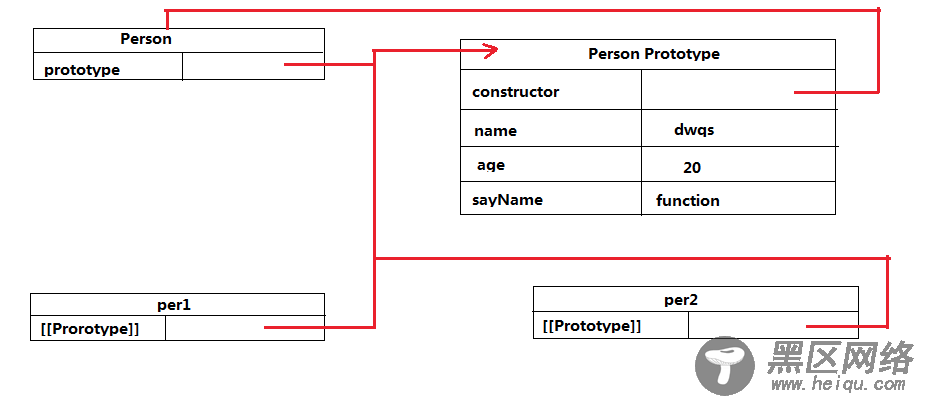构造函数和原型对象
构造函数也是函数,用new创建对象时调用的函数,与普通函数的一个区别是,其首字母应该大写。但如果将构造函数当作普通函数调用(缺少new关键字),则应该注意this指向的问题。
var name = "Pomy"; function Per(){ console.log("Hello "+this.name); } var per1 = new Per(); //"Hello undefined" var per2 = Per(); //"Hello Pomy"
使用new时,会自动创建this对象,其类型为构造函数类型,指向对象实例;缺少new关键字,this指向全局对象。
可以用instanceof来检测对象类型,同时每个对象在创建时都自动拥有一个constructor属性,指向其构造函数(字面量形式或Object构造函数创建的对象,指向Object,自定义构造函数创建的对象则指向它的构造函数)。
console.log(per1 instanceof Per); //true console.log(per1.constructor === Per); //true
每个对象实例都有一个内部属性:[[Prototype]],其指向该对象的原型对象。构造函数本身也具有prototype 属性指向原型对象。所有创建的对象都共享该原型对象的属性和方法。
function Person(){} Person.prototype.name="dwqs"; Person.prototype.age=20; Person.prototype.sayName=function() { alert(this.name); }; var per1 = new Person(); per1.sayName(); //dwqs var per2 = new Person(); per2.sayName(); //dwqs alert(per1.sayName == per2.sayName); //true

所以,实例中的指针仅指向原型,而不指向构造函数。 ES5提供了hasOwnProperty()和isPropertyOf()方法来反应原型对象和实例之间的关系
alert(Person.prototype.isPrototypeOf(per2)); //true per1.blog = "www.ido321.com"; alert(per1.hasOwnProperty("blog")); //true alert(Person.prototype.hasOwnProperty("blog")); //false alert(per1.hasOwnProperty("name")); //false alert(Person.prototype.hasOwnProperty("name")); //true
因为原型对象的constructor属性是指向构造函数本身,所以在重写原型时,需要注意constructor属性的指向问题。
function Hello(name){ this.name = name; } //重写原型 Hello.prototype = { sayHi:function(){ console.log(this.name); } }; var hi = new Hello("Pomy"); console.log(hi instanceof Hello); //true console.log(hi.constructor === Hello); //false console.log(hi.constructor === Object); //true
使用对象字面量形式改写原型对象改变了构造函数的属性,因此constructor指向Object,而不是Hello。如果constructor指向很重要,则需要在改写原型对象时手动重置其constructor属性
Hello.prototype = { constructor:Hello, sayHi:function(){ console.log(this.name); } }; console.log(hi.constructor === Hello); //true console.log(hi.constructor === Object); //false
利用原型对象的特性,我们可以很方便的在JavaScript的内建原型对象上添加自定义方法:
Array.prototype.sum=function(){ return this.reduce(function(prev,cur){ return prev+cur; }); }; var num = [1,2,3,4,5,6]; var res = num.sum(); console.log(res); //21 String.prototype.capit = function(){ return this.charAt(0).toUpperCase()+this.substring(1); }; var msg = "hello world"; console.log(msg.capit()); //"Hello World"
继承
利用[[Prototype]]特性,可以实现原型继承;对于字面量形式的对象,会隐式指定Object.prototype为其[[Prototype]],也可以通过Object.create()显示指定,其接受两个参数:第一个是[[Prototype]]指向的对象(原型对象),第二个是可选的属性描述符对象。
var book = { title:"这是书名"; }; //和下面的方式一样 var book = Object.create(Object.prototype,{ title:{ configurable:true, enumerable:true, value:"这是书名", wratable:true } });
字面量对象会默认继承自Object,更有趣的用法是,在自定义对象之间实现继承。
var book1 = { title:"JS高级程序设计", getTitle:function(){ console.log(this.title); } }; var book2 = Object.create(book1,{ title:{ configurable:true, enumerable:true, value:"JS权威指南", wratable:true } }); book1.getTitle(); //"JS高级程序设计" book2.getTitle(); //"JS权威指南" console.log(book1.hasOwnProperty("getTitle")); //true console.log(book1.isPrototypeOf("book2")); //false console.log(book2.hasOwnProperty("getTitle")); //false
当访问book2的getTitle属性时,JavaScript引擎会执行一个搜索过程:现在book2的自有属性中寻找,找到则使用,若没有找到,则搜索[[Prototype]],若没有找到,则继续搜索原型对象的[[Prototype]],直到继承链末端。末端通常是Object.prototype,其[[Prototype]]被设置为null。
实现继承的另外一种方式是利用构造函数。每个函数都具有可写的prototype属性,默认被自懂设置为继承自Object.prototype,可以通过改写它来改变原型链。
